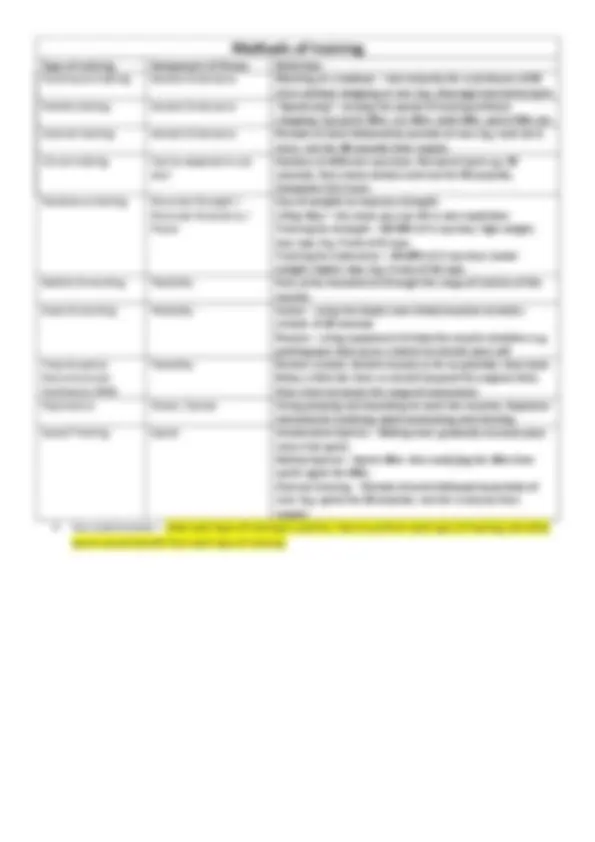



Study with the several resources on Docsity

Earn points by helping other students or get them with a premium plan


Prepare for your exams
Study with the several resources on Docsity

Earn points to download
Earn points by helping other students or get them with a premium plan
Community
Ask the community for help and clear up your study doubts
Discover the best universities in your country according to Docsity users
Free resources
Download our free guides on studying techniques, anxiety management strategies, and thesis advice from Docsity tutors
An overview of the components of fitness for btec sport, focusing on aerobic endurance, muscular strength, and the basic and advanced principles of training. Learn definitions, examples, testing protocols, and methods for each component and principle.
Typology: Slides
1 / 2

This page cannot be seen from the preview
Don't miss anything!


Revision topics – BTEC SPORT
Health Related components Skill Related components Aerobic Endurance Agility Muscular Strength Balance Muscular Endurance Coordination Body Composition Power Speed Reaction time Flexibility
Principle Definition / Example Frequency How often you train Intensity How hard you train Time How long you train for Type What type of training you do
Principle Definition / Example Specificity Training should be specific to your sport. Eg a marathon runner would need to perform continuous training. Progressive Overload Gradually increase the working intensity/effort over time. E.g. begin lifting 10kg weights, then over time increase to 12.5kg to improve muscular strength. Reversibility If training stops, then any gains are lost. This could be due to injury or illness. Adaptation Adaptation is where your body changes to be able to cope with the stress it is being put under. Exercise must be long enough for this to happen. Variation Having variety in your training to stop you getting bored and losing motivation. Rest and Recovery Your body needs to rest and recover to allow muscles to repair and improvements to occur. Individual needs Athletes will have different strengths/weaknesses and will need to make sure they are training to address these.
Aerobic Endurance Multi-stage fitness test (Bleep test) & Forestry step test Muscular Strength Hand-grip Dynamometer Muscular Endurance 1 min sit up test and 1 min press up test Body Composition Skin fold (Jackson Pollock Nomogram) & Bioelectrical Impedance Analysis (BIA) Speed 35m sprint test Flexibility Sit and reach test Agility Illinois Agility test Balance Stork stand test Coordination Alternative ball toss test Power Standing Vertical Jump & Standing Broad Jump (long jump) Reaction time Ruler drop test
Type of training Component of fitness Definition Continuous training Aerobic Endurance Working at a medium – low intensity for a minimum of 30 mins without stopping or rest. E.g. slow jog/row/swim/cycle Fartlek training Aerobic Endurance “Speed play”, varying the speed of training without stopping. E.g sprint 50m, run 50m, walk 50m, sprint 50m etc. Interval training Aerobic Endurance Periods of work followed by periods of rest. E.g. train for 2 mins, rest for 30 seconds then repeat. Circuit training Can be adapted to suit any! Stations of different exercises. Period of work e.g. 45 seconds, then move station and rest for 30 seconds. Complete full circuit. Resistance training Muscular Strength / Muscular Endurance / Power Use of weights to improve strength. 1 Rep Max – the most you can lift in one repetition. Training for strength – 80 - 90% of 1 rep max, high weight, low reps. E.g. 3 sets of 6 reps. Training for endurance – 50 - 60% of 1 rep max. Lower weight, higher reps. E.g. 5 sets of 12 reps. Ballistic Stretching Flexibility Fast, jerky movements through the range of motion of the muscle. Static Stretching Flexibility Active – using the body’s own limbs/muscles to hold a stretch. 8-10 seconds Passive – using equipment to help the muscle stretches e.g. putting your foot up on a bench to stretch your calf Proprioceptive Neuromuscular Facilitation (PNF) Flexibility Partner stretch. Stretch muscle as far as possible, then hold. Relax a little bit, then re-stretch beyond the original limit. Over time increases the range of movement. Plyometrics Power / Speed Using jumping and bounding to work the muscles. Explosive movements involving rapid contracting and relaxing. Speed Training Speed Acceleration Sprints – Rolling start, gradually increase pace into a full sprint Hollow Sprints – Sprint 40m then walk/jog for 20m then sprint again for 40m. Interval training - Periods of work followed by periods of rest. E.g. sprint for 20 seconds, rest for 1 minute then repeat.